One man’s world record-breaking quest to climb the Seven Summits

Almost 3,500 days later, as the crippling pain in his lower back erupted in spasm with each step, Daniel Bull clambered over the thin crest of rock and looked down onto a white infinity. From the summit of Mount Vinson, the tallest peak on the Antarctic continent, he could make out the nunataks that jut out the ground like pyramids of rock; the sheets of blue ice that melt seamlessly into the horizon. For a moment, breathing in the paper-thin air at 16,050ft, it felt as though he was standing at the edge of the Earth. “This is the closest I’ll ever be to being on another planet.”
At 36 years old, after a journey encompassing every continent, life and death, obsession and endless perseverance, Bull had become the youngest person in history – by over a decade – to climb the Seven Summits and the Seven Volcanic Summits, trekking insect-infested swamps, tribal land, and barely charted towers of ice. After posing for photos and marking the spot on his GPS tracking device, he used the last of his energy to kneel down and fill a bottle with snow.
****
Thirty-one metres above sea level. Melbourne.
At some point during his childhood, Daniel Bull became gripped by a fascination for heights. There wasn’t one moment to be precise: there was the picture of the Matterhorn – “a majestic peak” – in his classroom, the typical childhood rituals of climbing trees and walls, but nothing could quite explain why he found himself, aged 15, staring down a frozen waterfall in Australia’s Alps. Somewhere in those formative years, though, the idea was permanently lodged: to start at the beach and “reach as high as humanly possible.”
While finishing school, he’d began working as a labourer, polishing 1,000 bricks a day for $50 to fund courses in mountaineering and survival training. He learnt how to build ice caves and manage oxygen supplies, read about famous climbers and watched countless documentaries. And, shortly after leaving school, he headed for the Himalayas for the first time.
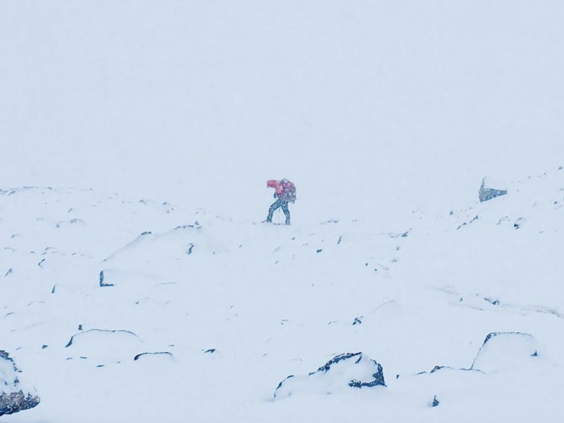
Sir Edmund Hillary, the first man to summit Everest (along with Tenzing Norgay), once labelled Ama Dablam “unclimbable”; a 22,349ft peak that casts a shadow over the route towards Everest basecamp. For Bull, it was a thrilling but recklessly optimistic first choice. Dazed and dehydrated, without the fitness or know-how, he reached the summit in a bleary state. But at the start of the descent – typically the most hazardous bit of any climb – he failed to realise that one of the vertical ropes harnessed to the cliff face had frozen over. As he leant back over the ledge to abseil around 50 metres, he plummeted into free-fall.
Overcome with panic, he used his free hand to swing an ice-axe and desperately kicked his crampons into the face in a bid to create any form of friction. Eventually, just seconds away from a life-threatening injury, or perhaps worse, his boots stuck into the ice, causing his spine to arch back at a wincing angle. Suspended upside down, the blood rushing to his head, he was frozen by the shock. “I just hung onto the rope for a few minutes, it all happened in a matter of seconds, I was very shaken.”
It was Bull’s first near-death experience. The flood of anxiety washed through his mind: what am I doing here? Why am I risking my life? Is it worth it? But fear – the most innate of human reactions – can be intoxicating, even addictive. Ama Dablam was, in every sense, only the beginning. “And then I looked up and told the next guy it was his turn.”
****
For over three decades, the Seven Summits – comprised of the highest mountain on each continent – was the unreachable pinnacle of the mountaineering world. In 1970, Naomi Uemura, a Japanese explorer, climbed six of the peaks in a single year but disappeared in a violent snowstorm while training for Antarctica. His fate, for those pursuing deified status within the climbing world, was not uncommon.
In 1978, though, legendary Italian climber Reinhold Messner also summited six of the seven peaks. The first man to complete a solo climb of Everest, he spent years plotting his own route to the top of Vinson, but was ultimately pipped seven years later by Richard Bass, a little-known ski resort owner from Utah.
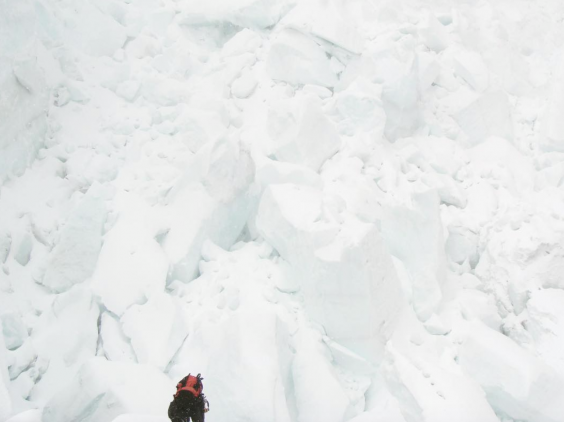
Debate has often been vociferous over a definitive list of the summits, simply due to the fact that new territories have since been discovered. Elbrus, a remote slope near to the Chechen Republic replaced France’s Mont Blanc. Puncak Jaya, a dramatic peak spiking out the New Guinean jungle, replaced Australia’s Kosciuszko.
Today’s accepted version is as follows:
Everest (29,030ft), Nepal, Asia
Aconcagua (22,840ft), Argentina, South America
Denali (20,310ft), Alaska, North America
Kilimanjaro (19,340), Tanzania, Africa
Elbrus (18,510ft), Russia, Europe
Vinson (16,050ft), Antarctica
Puncak Jaya (16,020ft), Indonesia, Oceania
What started as a hobby transformed into a type of pilgrimage, with Bull fixated by testing his body against the greatest extremes and exploring the Earth’s least-trodden foothills. His initial goal was to climb Everest, the fantasy of all climbers, and still the most challenging of all the summits. So, to prepare for his return to Nepal, he began to tick off some of the gentler climbs – as far as 20 days of enduring trekking towards the heavens can be comfortable.
To take the first steps towards Elbrus, he accepted a job at an IT consultancy firm in Germany. From there, he flew to Mineralnye Vody, Russia and began the eerie drive through the western Caucasus, near to Chechnya and the Georgian border, and was stopped multiple times by armed officials en route before reaching the base of the mountain. The climb itself was manageable, a test of endurance rather than technical ability, but the altitude jarred, with his 6’3” frame like an anchor to the snow. By the time he eventually approached the summit, his body felt hollow with aches and dizziness. “I was almost crawling the final few metres,” he says. “Instead of standing triumphantly on the summit, all I could think about was trying to breathe, just to take in some oxygen.”
A year later, he set out to tackle Kilimanjaro. Widely accepted as the easiest of the seven, it was, in essence, supposed to be little more than a training exercise, crammed into the space of five days. But again, as he traversed the scenic route that overlooks the Serengeti, the altitude sickness formed a vice against his chest. Almost an hour before reaching the summit, he began projectile vomiting, inducing a bout of severe dehydration that could only be appeased by taking on more water, and thereby renewing the cycle. After just a matter of minutes at the mountaintop, he began jogging downward until the nausea finally ebbed away.
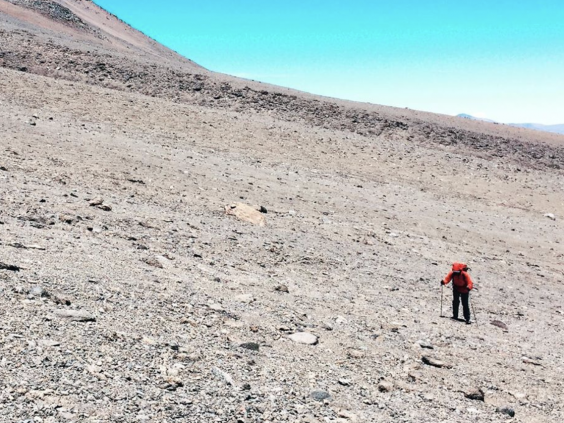
Despite his excitement and urgency, Bull knew he wasn’t quite ready. Instead, he began working multiple jobs in London to raise the money to climb Aconcagua – a trip, like the vast majority of the summits, that requires financing going into thousands of pounds. Known as ‘the sentinel of stone’, situated in the heart of the Andes, it is the highest mountain outside of the Himalayas. The climb itself begins with a long, grinding trek through the dirt and dust of the Vacas Valley before morphing into a maze of rivers two or three times the size of the Thames. After wading to the base of the mountain, several members of the expedition party had to be helicoptered home. But, this time, Bull had the strength and confidence, and crucially the experience. When another climber in his troupe fell into a semi-conscious state on the summit, he and a few others had the strength to carry them down. “That’s when I decided I was ready for Everest.”
****
Standing on a ledge below the Hillary Step, Bull collapsed back against the snow. With his oxygen running low, he’d unhooked himself from the vertical rope as he attempted to avoid the queues forming like multicoloured trails of dots across the mountain. To summit Everest, he’d set off from high camp a few hours before midnight to avoid the traffic jam of climbers who congregate on the ascent. His body ached, having trekked up from base camp through the melting glacier known as the Khumbu Icefall multiple times – due to its labyrinth of ice shards and snow boulders, owing to frequent avalanches – to acclimatise to the altitude. Each crossing, including rickshaw ladders over vast crevasses, is a game of Russian roulette – in 2014, 16 sherpas were tragically swept away in an avalanche.
As he finally prepared to make his summit bid, a storm enveloped the mountain, forcing Bull to spend a day in the Death Zone – the point of altitude at which it’s no longer possible for the body to adapt and oxygen steadily leaves the blood. Every hour, he would wake up in a fit of hypoxia, gasping for air after his body had essentially shut down and stopped breathing.
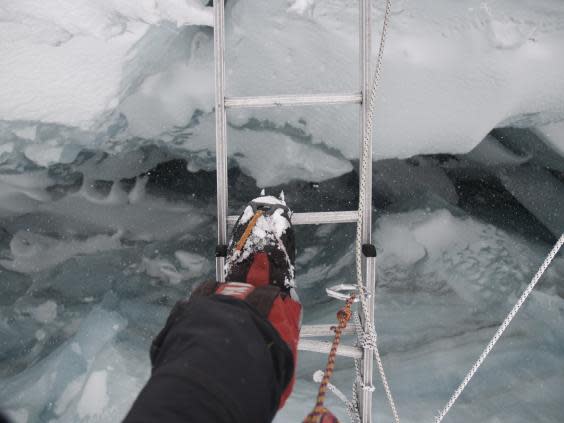
On 22 May 2008, Bull was among the first to reach the summit. He spent half-an-hour there, lost in wonder and awe, the entire world beneath his feet. “Then, the feeling of triumph was quickly replaced by dread.” Every step downward felt like a war with his own body. Sitting against the snow all alone, the colour of his down suit blurred ever so slightly beyond his glasses and he stayed there, sinking into stupor, blanketed by the cold. Out of the corner of his eye, he spotted someone relaxing in an identical position a dozen or so metres away. For a moment, the sight of company gave him comfort. “Then I realised he must have been there for a few years.”
“I did a double-take and realised this person was covered in this thin layer of ice,” he says. “I saw the similarities, the way we were both sitting. It dawned on me that that could be my fate if I stayed there any longer. It stunned me to my feet. I think seeing that body possibly saved my life. Without it, I’m not sure if I’d have got back up.”
Others on the trip had not been so lucky. A Swiss mountain guide, who’d been travelling with a Sherpa Bull had befriended on his first trip to the Himalayas, passed away on the descent.
“There’s relief, elation, the feeling of success, and yet it’s also horrible. I’d met him at base camp, I’d go over and speak to him. You find yourself struggling with all these different emotions.”
****
When Bull returned from Everest, the conflicting emotions had appeased his appetite. That elusive goal, the sense of trial and validation, had been fulfilled. For almost five years, he didn’t even consider setting off on any new climbs. But then, he heard of a Russian climber who too was near to completing the Seven Summits, and attempting to beat him to the world record. “That’s when the mountains called again”.
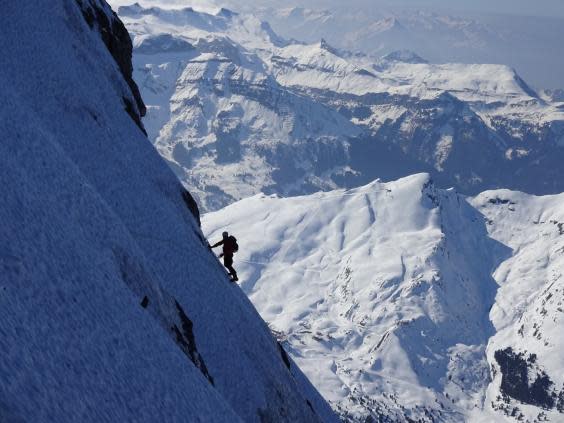
Denali, in northern Alaska, is one of the most remote peaks on Earth. The climb itself has roughly only a 50 per cent success rate. But, by now, Bull had the wherewithal to challenge any mountain, pushing himself to breaking point against an invisible rival. Due to the intense light, he climbed during the night under the midnight sun to minimise the risk of falling into a crevasse. After reaching high camp, a blistering snowstorm swept in. For three days, he was trapped in his tent at 17,200ft and only on the final day before their supplies were emptied did the most blinding, perfect sun break through the fog. As they reached the summit, he wore just a single layer of thermals.
Seven Summits
Summit date and duration of each climb
Elbrus, 1 August 2006, 12 days
Kilimanjaro, 30 August 2007, 5 days
Aconcagua, 23 February 2008, 20 days
Everest, 22 May 2008, 60 days
Denali, 17 June 2013, 25 days
Puncak Jaya, 19 March 2014, 20 days (including jungle trek to base camp)
Vinson & Sidley, 4 & 14 January 2017, 30 days
His penultimate summit, Puncak Jaya, is one of the most technical and unique climbs on Earth. First, just to reach the Indonesian mountain, Bull had to make contact with the local Damal Tribe in New Guinea, who led the week-long expedition through dense jungle in the native highland area. The heat was cloying, like being bled dry in a sauna. At first, he attempted to swat the swathes of mosquitos and insects away from his face. But soon he realised it was futile and was helpless as they pricked at his forehead. By the time they finally emerged above the canopy, his skin was pockmarked by bites and his toenails had come loose due to stubbing them against the web of tree roots.
The final day of the ascent is almost purely a rock climb, using harnesses, carabiners and repelling devices, before a Tyrolean traverse – crossing a huge void between peaks with use only of a wire – between cliff faces. After 12 gruelling hours navigating the overhang’s narrow gullies, Bull reached the peak.
****
For a second, as he stood there on the summit of Vinson, Bull was overcome with emotion. He had completed the work of a lifetime, set a world record, defied near-death encounters and conquered the earth’s most extreme climates. Finally, the void had been filled. But, before leaving Antarctica, he had planned one last expedition.
While sitting back in Union Glacier Camp, celebrating with a weird concoction of spirits brought by fellow travellers, his mind drifted towards Mount Sidley. The highest and most remote volcano on Earth, it hadn’t been climbed in years. Nor had any Australian ever attempted the feat. Still carrying injuries from the climb of Vinson – a searing strain that stretched the length of his spine – the following day they boarded a modified Basler DC3 prop plane and flew west for four hours from the Antarctic peninsula. Eventually, in the distance, a huge volcano came into view, projecting out of the polar icecap, with a blue ice coating and mounds of snow that looked like mushroom clouds surrounding the crater.
There are no runways surrounding Sidley. It is, to a large extent, educated guesswork. The territory is, technically, unclaimed and accounts for the biggest no man’s land on the planet. To land the plane, pilots first have to do several test runs, bringing the wheels down against the ice before quickly lifting up again in case it cracks. Only once the check has been completed several times will they deem it safe to land. From thereon, the pilots set up a tent beneath it, shaded from the harsh winds that gust along the surface.
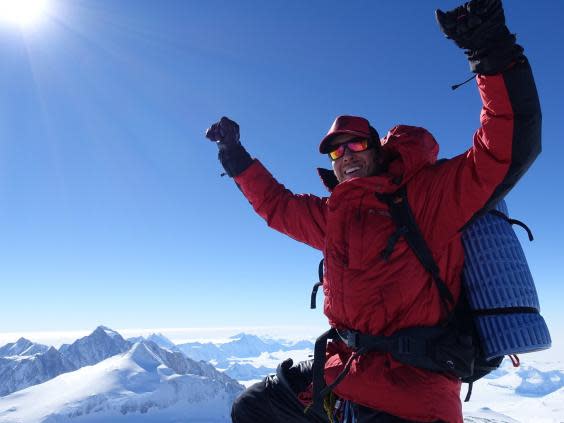
There is little documented about Sidley’s climbing routes, with the volatile weather quickly masking past tracks, nor any established high camp. So, after the long, pummelling ascent up the volcano, the ground soft and sinking beneath his feet, Bull was forced to find a random spot of shelter when the weather turned. He waited there for two days until the storm passed, the temperature falling to -40C – the point where Celsius meets Fahrenheit – as katabatic winds swept the mountain. Eventually, though, after easing across a last narrow ledge, he caught a glimpse of the enormous crater below, 1,200 metres deep, dropping steeply into what seemed like an eternal nothingness.
Bull pulled out his GPS phone and sent a text to his father, who’d nervously tracked every one of his adventures. “Hopefully leaving west Antarctica soon. Looking forward to seeing you back home”.
After arriving back in Melbourne, he froze the water from the bottle into cubes and made a whisky on the rocks. He had brought the most remote mountain, the memories of a decade’s work, the pain, emotion, exhilaration, joy and, at times, sadness, all the way back to the sea.

 Yahoo News
Yahoo News 
